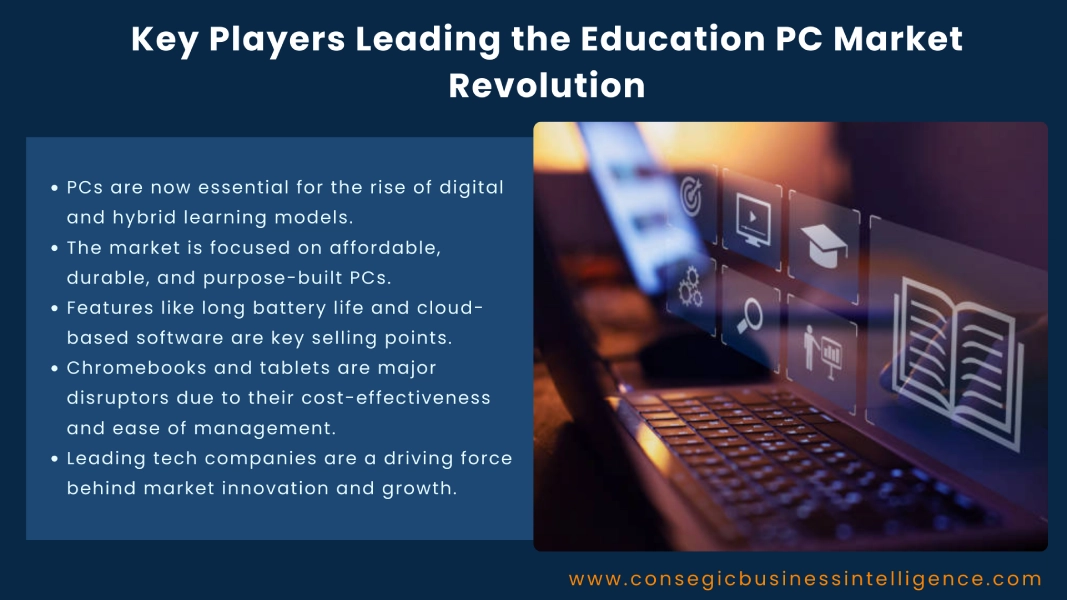Key Players Leading the Education PC Market Revolution
The education PC market is undergoing a major transformation as schools, universities, and online learning platforms increasingly adopt digital tools to enhance teaching and learning. Education PCs ranging from laptops and desktops to tablets and Chromebooks are now essential for classrooms, remote learning, and hybrid education models.

The rising demand for affordable, durable and high-performance PCs has encouraged global technology leaders to design devices tailored specifically for education. These PCs often emphasize features like long battery life, cloud integration, rugged design, and collaborative software. Several prominent companies are shaping this revolution, bringing innovation and accessibility to learners worldwide.
Below are few prominent key players leading the education PC market globally.
- Dell Technologies
Dell has long been a trusted name in education industry. Its range of laptops and Chromebooks is designed to withstand the challenges of student use, offering durable builds and spill-resistant keyboards. The Latitude and Chromebook series provide strong performance, while Dell’s support services ensure institutions have reliable IT assistance. With a focus on security and manageability, Dell continues to be a leading choice for schools worldwide.
- HP Inc.
HP has established itself as a top contender in the education PC segment. Its Chromebook and ProBook series are widely adopted by schools due to their affordability, portability, and robust features. HP’s education-focused devices often come with long battery life, quick boot-up times, and integrated collaboration tools. By working closely with educators, HP designs products that align with digital learning needs, making it a trusted partner in the global education ecosystem.
- Lenovo
Lenovo has emerged as one of the most prominent players in the education PC market. Its ThinkPad and IdeaPad models are known for durability and reliability, while its Lenovo Chromebooks are especially popular in classrooms. The company also emphasizes accessibility, offering a wide range of price points to ensure institutions can meet diverse student needs. With strong partnerships in both K-12 and higher education, Lenovo is helping drive digital inclusion.
- Acer Inc.
Acer has carved out a strong position in the education market, particularly with its Chromebook lineup. Known for delivering value-driven performance, Acer’s devices are lightweight, cost-effective, and optimized for cloud-based education platforms like Google Workspace. The brand also invests in ruggedized designs, ensuring durability for younger students. Acer’s growing presence in global schools highlights its role in expanding affordable digital learning solutions.
- Apple Inc.
Apple continues to be a major force in education with its MacBook and iPad lineup. While generally positioned at higher price points, Apple devices are valued for their user-friendly interface, reliability, and extensive app ecosystem. The iPad, in particular, has transformed interactive learning through tools like Apple Pencil and classroom management apps. Apple’s commitment to accessibility and creativity-driven education makes it a key player, especially in higher education and creative learning spaces.
- Microsoft
Microsoft is both a software and hardware leader in education. Its Surface lineup, including the Surface Go and Surface Laptop, combines performance with portability for students and educators. More importantly, Microsoft provides an integrated ecosystem through Windows and Microsoft 365, enabling collaboration, productivity, and secure learning environments. Its partnerships with schools around the world have positioned Microsoft as a cornerstone of modern digital classrooms.
- Samsung Electronics
Samsung has steadily expanded its presence in the education PC market with its Galaxy Chromebook and tablet range. Known for sleek designs and strong integration with Android and Google services, Samsung devices cater well to hybrid and remote learning environments. Its focus on mobility, display quality, and stylus support makes Samsung a strong competitor in education-focused digital tools.
- ASUS
ASUS is another major brand reshaping the education PC market. The company offers a wide variety of Chromebooks and laptops that balance affordability with innovation. Features like military-grade durability, spill-resistant keyboards, and efficient processors make ASUS devices well-suited for classrooms. Its commitment to value-driven solutions has allowed it to compete strongly with other global leaders in the education sector.
While Google is not a hardware giant like others, its role in the education PC market is undeniable. Through its Chrome OS ecosystem and partnerships with manufacturers like HP, Dell, and Acer, Google has driven the widespread adoption of Chromebooks in schools. With easy management, fast boot times, and integration with Google Workspace for Education, Google has created a learning environment that is both affordable and efficient for students and institutions.
- Huawei
Huawei is making footsteps in education PCs, especially in emerging markets. Its MateBook laptops and tablets are gaining popularity due to competitive pricing, strong performance, and sleek design. While Huawei faces challenges in some regions, its expanding product portfolio and focus on accessibility make it a brand to watch in the education space.
Conclusion
The education PC market is being reshaped by leading technology players who are blending innovation, affordability, and accessibility. Dell, HP, Lenovo, and Acer dominate with durable, classroom-ready Chromebooks and laptops, while Apple and Microsoft continue to drive premium experiences with strong ecosystems. Samsung, ASUS, Google, and Huawei are also expanding their influence, offering unique solutions that support modern learning needs.
As education continues to evolve with hybrid and digital models, these companies are not only supplying devices but also enabling a connected, collaborative, and inclusive learning future. The revolution in education PCs is just beginning, and these key players are at the forefront of defining how students learn in the digital age.
